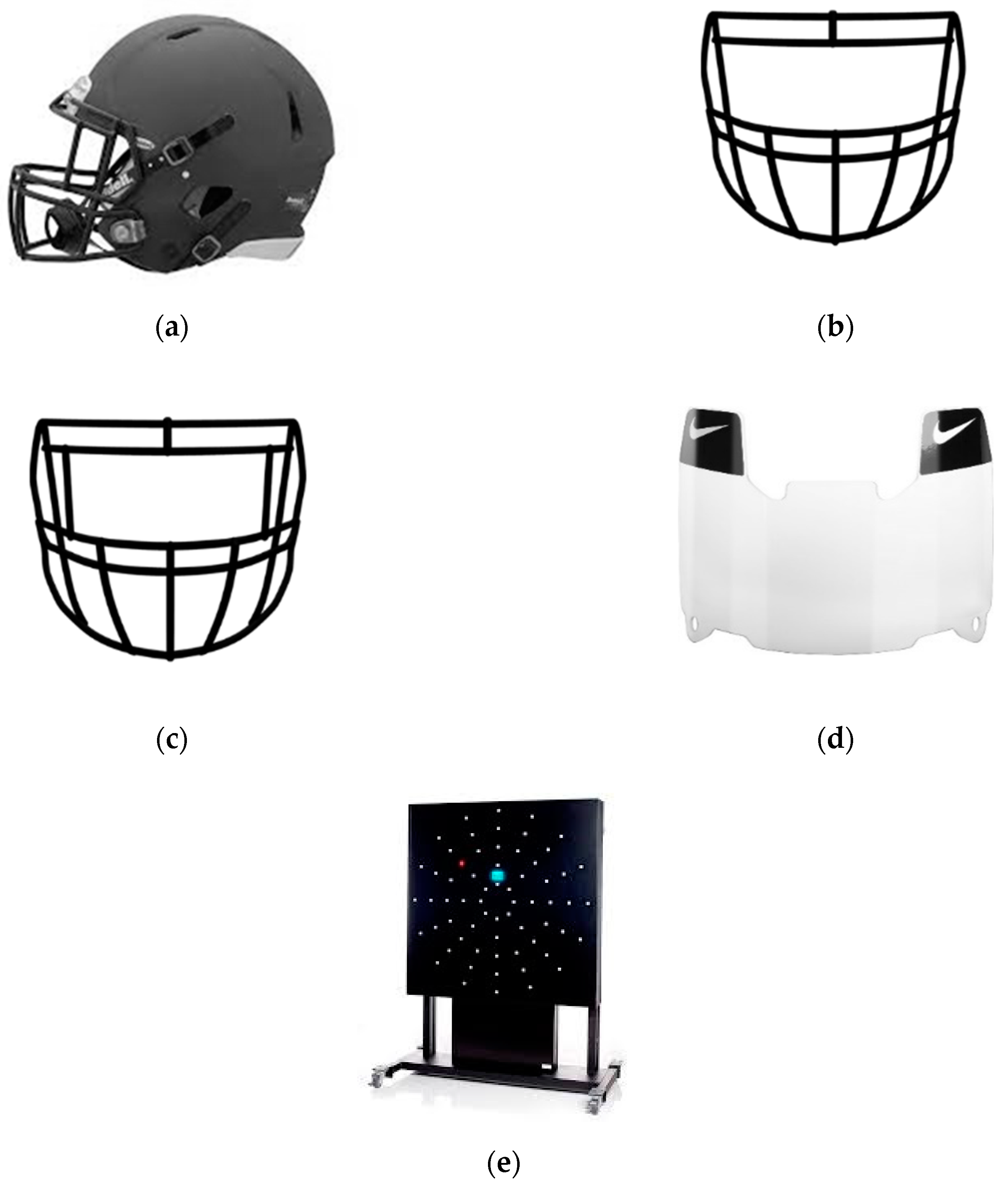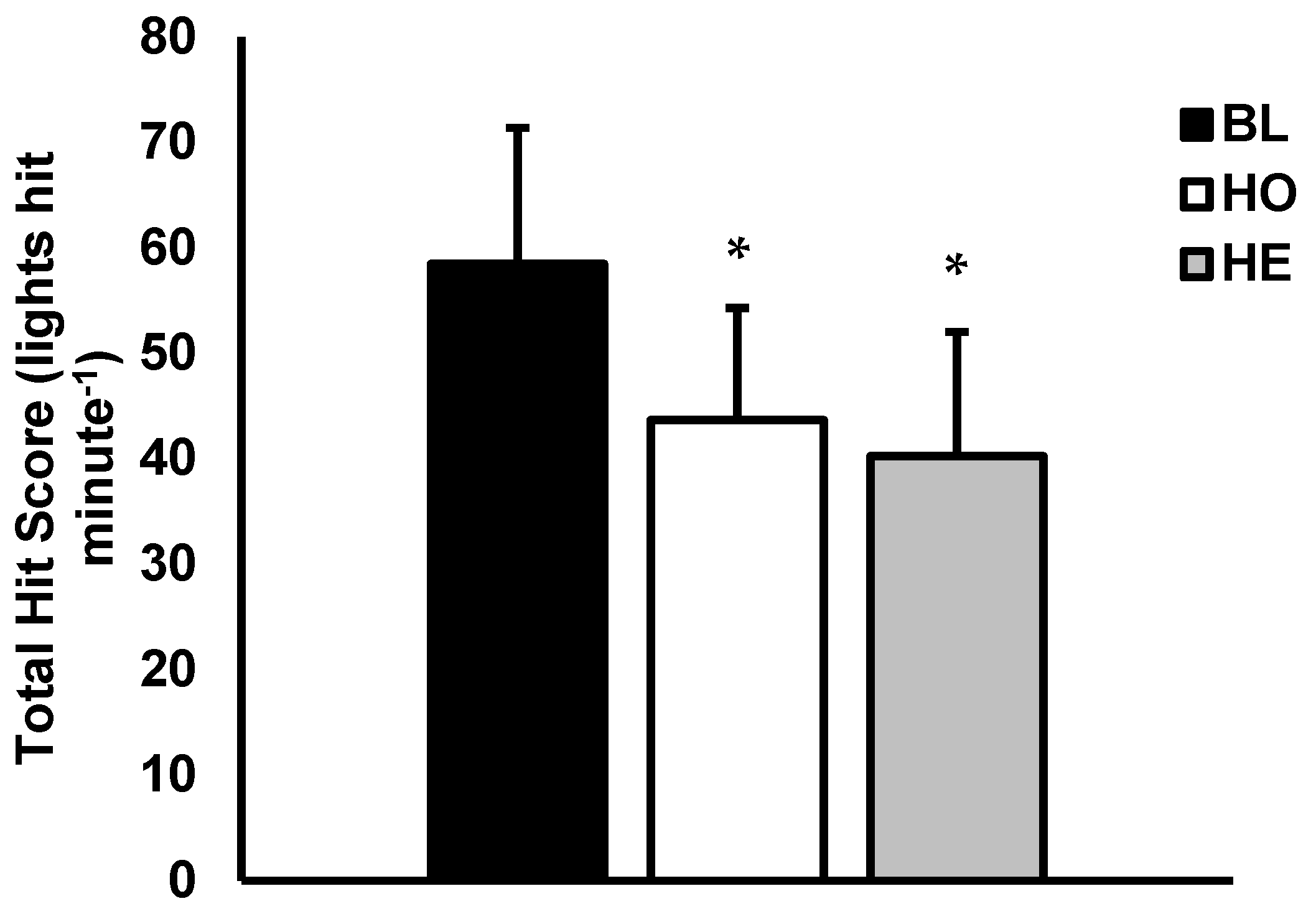Effects of Protective American Football Headgear on Peripheral Vision Reaction Time and Visual Target Detection in Division I NCAA Football Players
Abstract
1. Introduction
2. Materials and Methods
2.1. Subjects
2.2. Experimental Procedures
2.3. Statistical Analysis
3. Results
3.1. Visual Target Detection
3.2. Peripheral Reaction Time
4. Discussion
Author Contributions
Funding
Acknowledgments
Conflicts of Interest
References
- Levy, M.L.; Ozgur, B.M.; Berry, C.; Aryan, H.E.; Apuzzo, M.L. Birth and evolution of the football helmet. Neurosurgery 2004, 55, 656–662. [Google Scholar] [CrossRef] [PubMed]
- Levy, M.L.; Ozgur, B.M.; Berry, C.; Aryan, H.E.; Apuzzo, M.L. Analysis and evolution of head injury in football. Neurosurgery 2004, 55, 649–655. [Google Scholar] [CrossRef] [PubMed]
- Schneider, R.C.; Antine, B.E. Visual-field impairment related to football headgear and face guards. JAMA 1965, 192, 616–618. [Google Scholar] [CrossRef] [PubMed]
- Committee on Sports Medicine and Fitness. Protective eyewear for young athletes. Pediatrics 2004, 113, 619–622. [Google Scholar] [CrossRef]
- Rowson, S.; Duma, S.M.; Greenwald, R.M.; Beckwith, J.G.; Chu, J.J.; Guskiewicz, K.M.; Mihalik, J.P.; Crisco, J.J.; Wilcox, B.J.; McAllister, T.W. Can helmet design reduce the risk of concussion in football? J. Neurosurg. 2014, 120, 919–922. [Google Scholar] [CrossRef]
- Collins, M.; Lovell, M.R.; Iverson, G.L.; Ide, T.; Maroon, J. Examining concussion rates and return to play in high school football players wearing newer helmet technology: A three-year prospective cohort study. Neurosurgery 2006, 58, 275–286. [Google Scholar] [CrossRef]
- Benson, B.W.; Hamilton, G.M.; Meeuwisse, W.H.; McCrory, P.; Dvorak, J. Is protective equipment useful in preventing concussion? A systematic review of the literature. Br. J. Sports Med. 2009, 43, i56–i67. [Google Scholar] [CrossRef]
- Gammons, M.R. Helmets in sport: Fact and fallacy. Curr. Sports Med. Rep. 2013, 12, 377–380. [Google Scholar] [CrossRef]
- Sone, J.Y.; Kondziolka, D.; Huang, J.H.; Samadani, U. Helmet efficacy against concussion and traumatic brain injury: A review. J. Neurosurg. 2017, 126, 768–781. [Google Scholar] [CrossRef]
- Crisco, J.J.; Fiore, R.; Beckwith, J.G.; Chu, J.J.; Brolinson, P.G.; Duma, S.; McAllister, T.W.; Duhaime, A.-C.; Greenwald, R.M. Frequency and location of head impact exposures in individual collegiate football players. J. Athl. Train. 2010, 45, 549–559. [Google Scholar] [CrossRef]
- Clark, J.F.; Graman, P.; Ellis, J.K.; Mangine, R.E.; Rauch, J.T.; Bixenmann, B.; Hasselfeld, K.A.; Divine, J.G.; Colosimo, A.J.; Myer, G.D. An exploratory study of the potential effects of vision training on concussion incidence in football. Optom. Vis. Perform. 2015, 3, 116–125. [Google Scholar]
- McKnight, A.J.; McKnight, A.S. The effects of motorcycle helmets upon seeing and hearing. Accid. Anal. Prev. 1995, 27, 493–501. [Google Scholar] [CrossRef]
- Ruedl, G.; Herzog, S.; Schöpf, S.; Anewanter, P.; Geiger, A.; Burtscher, M.; Kopp, M. Do ski helmets affect reaction time to peripheral stimuli? Wilderness Environ. Med. 2011, 22, 148–150. [Google Scholar] [CrossRef] [PubMed]
- Ing, E.; Ing, T.; Ing, S. The effect of a hockey visor and sports goggles on visual function. Can. J. Ophthalmol. 2002, 37, 161–167. [Google Scholar] [CrossRef]
- Dawson, M.L.; Zabik, R.M. Effect of protective eyewear on reaction time in the horizontal field of vision. Percept. Mot. Skills 1988, 67, 115–120. [Google Scholar] [CrossRef] [PubMed]
- Kauffman, D.C.; Clark, J.F.; Smith, J.C. The influence of sport goggles on visual target detection in female intercollegiate athletes. J. Sports Sci. 2015, 33, 1117–1123. [Google Scholar] [CrossRef]
- Wilkins, L.; Mann, D.; Dain, S.; Hayward, T.; Allen, P. Out with the old, in with the new: How changes in cricket helmet regulations affect the vision of batters. J. Sports Sci. 2019, 37, 13–19. [Google Scholar] [CrossRef]
- Kramer, M.R.; Wasserman, E.B.; Teel, E.F.; Mihalik, J.P. Effect of protective helmets on vision and sensory performance. Br. J. Sports Med. 2017, 51, A65. [Google Scholar] [CrossRef]
- American College of Sports Medicine. ACSM’s Exercise Testing and Prescription, 10th ed.; Lippincott Williams & Wilkins: Philadelphia, PA, USA, 2017. [Google Scholar]
- Wells, A.J.; Hoffman, J.R.; Beyer, K.S.; Jajtner, A.R.; Gonzalez, A.M.; Townsend, J.R.; Mangine, G.T.; Robinson, E.H., IV; McCormack, W.P.; Fragala, M.S. Reliability of the dynavision™ d2 for assessing reaction time performance. J. Sports Sci. Med. 2014, 13, 145. [Google Scholar]
- Vesia, M.; Esposito, J.; Prime, S.L.; Klavora, P. Correlations of selected psychomotor and visuomotor tests with initial Dynavision performance. Percept. Mot. Skills 2008, 107, 14–20. [Google Scholar] [CrossRef]
- Cohen, J. Statistical Power Analysis for the Behavioral Sciences, 2nd ed.; Erlbaum Associates: Hillsdale, MI, USA, 1988. [Google Scholar]
- Post, A.; Oeur, A.; Hoshizaki, B.; Gilchrist, M.D. An examination of American football helmets using brain deformation metrics associated with concussion. Mater. Des. 2013, 45, 653–662. [Google Scholar] [CrossRef]
- Stine, C.D.; Arterburn, M.R. Vision and Sports: A Review of the Literature. Master’s Thesis, Pacific University, Forest Grove, OR, USA, 1982. [Google Scholar]
- Hitzeman, S.A.; Beckerman, S. What the literature says about sports vision. Optom. Clin. 1993, 3, 145–169. [Google Scholar] [PubMed]
- González-Alvarez, C.; Subramanian, A.; Pardhan, S. Reaching and grasping with restricted peripheral vision. Ophthalmic Physiol. Opt. 2007, 27, 265–274. [Google Scholar] [CrossRef] [PubMed]
- Brenton, J.; Müller, S.; Harbaugh, A.G. Visual-perceptual training with motor practice of the observed movement pattern improves anticipation in emerging expert cricket batsmen. J. Sports Sci. 2019, 1–8. [Google Scholar] [CrossRef] [PubMed]


| Reaction Time | Baseline (BL) | Helmet Only (HO) | Helmet + Eye Shield (HE) |
|---|---|---|---|
| Average (s) | 1.08 ± 0.26 | 1.45 ± 0.35 * | 1.68 ± 0.81 * |
| Peak (s) | 0.57 ± 0.11 | 0.65 ± 0.11* | 0.66 ± 0.12 * |
| Minimum (s) | 3.07 ± 1.03 | 5.28 ± 2.29 * | 5.83 ± 5.13 * |
| Median (s) | 0.88 ± 0.17 | 1.08 ± 0.21 * | 1.19 ± 0.32 * |
| Ring 3 (s) | 0.84 ± 0.18 | 1.08 ± 0.21 * | 1.16 ± 0.56 * |
| Ring 4 (s) | 1.13 ± 0.28 | 1.37 ± 0.41 * | 1.49 ± 0.46 * |
| Ring 5 (s) | 1.24 ± 0.36 | 1.77 ± 0.50 * | 1.92 ± 1.03 * |
© 2019 by the authors. Licensee MDPI, Basel, Switzerland. This article is an open access article distributed under the terms and conditions of the Creative Commons Attribution (CC BY) license (http://creativecommons.org/licenses/by/4.0/).
Share and Cite
Miller, R.A.; Rogers, R.R.; Williams, T.D.; Marshall, M.R.; Moody, J.R.; Hensarling, R.W.; Ballmann, C.G. Effects of Protective American Football Headgear on Peripheral Vision Reaction Time and Visual Target Detection in Division I NCAA Football Players. Sports 2019, 7, 213. https://doi.org/10.3390/sports7090213
Miller RA, Rogers RR, Williams TD, Marshall MR, Moody JR, Hensarling RW, Ballmann CG. Effects of Protective American Football Headgear on Peripheral Vision Reaction Time and Visual Target Detection in Division I NCAA Football Players. Sports. 2019; 7(9):213. https://doi.org/10.3390/sports7090213
Chicago/Turabian StyleMiller, Rachel A., Rebecca R. Rogers, Tyler D. Williams, Mallory R. Marshall, Justin R. Moody, Robert W. Hensarling, and Christopher G. Ballmann. 2019. "Effects of Protective American Football Headgear on Peripheral Vision Reaction Time and Visual Target Detection in Division I NCAA Football Players" Sports 7, no. 9: 213. https://doi.org/10.3390/sports7090213
APA StyleMiller, R. A., Rogers, R. R., Williams, T. D., Marshall, M. R., Moody, J. R., Hensarling, R. W., & Ballmann, C. G. (2019). Effects of Protective American Football Headgear on Peripheral Vision Reaction Time and Visual Target Detection in Division I NCAA Football Players. Sports, 7(9), 213. https://doi.org/10.3390/sports7090213







